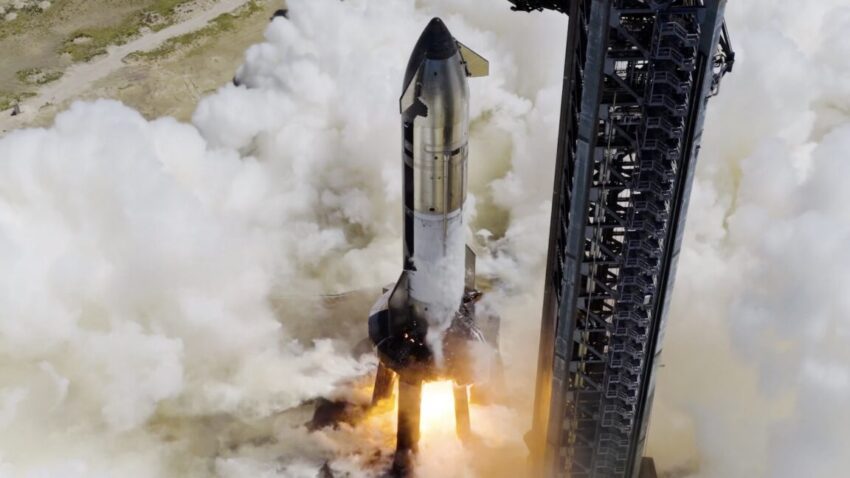
spacex has a few tricks up its SpaceX is gearing up for its final Starship flight of the year, with plans that include several key tests aimed at enhancing the rocket’s capabilities.
spacex has a few tricks up its
Overview of the Upcoming Flight
On the surface, the flight plan for SpaceX’s next Starship mission appears similar to its previous endeavors. The mission will once again see the Super Heavy booster splash down in the Gulf of Mexico, just offshore from SpaceX’s launch site in South Texas. Meanwhile, the Starship upper stage is set to embark on a suborbital trajectory, reentering the atmosphere over the Indian Ocean and ultimately aiming for a water landing northwest of Australia.
Key Objectives of the Flight
This upcoming flight is not merely a repetition of past missions; it is designed to test several critical systems that will be essential for future operations. Among the primary objectives are:
- Satellite Deployment: SpaceX will again test the rocket’s satellite deployer, a crucial component for future missions that aim to deliver payloads into orbit.
- Engine Reignition: The mission will also involve reigniting one of the Raptor engines in space. This maneuver is vital for adjusting the vehicle’s trajectory during reentry, which is a significant aspect of ensuring a safe landing.
- Data Collection: Engineers will collect extensive data throughout the flight to analyze the rocket’s performance and identify areas for improvement.
Significance of the Tests
The tests planned for this flight are particularly important as they lay the groundwork for future Starship missions aimed at low-Earth orbit (LEO). To date, all of SpaceX’s Starship ascents have been designed to conclude before reaching orbital velocity. This upcoming flight marks a step toward achieving the capability to reach and maintain orbit, a critical milestone for the company’s long-term goals.
Technical Challenges
While the flight plan may seem straightforward, it is essential to recognize the technical challenges involved. The Starship system is complex, and each test flight provides invaluable data that can help refine its design and operational protocols. The successful reignition of the Raptor engine in space is particularly challenging, as it requires precise timing and coordination to ensure that the engine performs optimally under varying conditions.
Historical Context
SpaceX’s journey with the Starship program has been marked by a series of ambitious goals and significant milestones. Since its inception, the program has aimed to develop a fully reusable spacecraft capable of carrying humans and cargo to destinations such as the Moon and Mars. Each test flight has contributed to the iterative design process, allowing engineers to learn from successes and failures alike.
The first successful flight of the Starship prototype occurred in December 2020, when SN8 achieved a high-altitude test flight. Since then, the program has progressed rapidly, with numerous prototypes undergoing testing. Each flight has provided critical insights into the rocket’s performance, leading to design modifications that enhance its reliability and efficiency.
Future Implications
The upcoming flight is not just a routine test; it represents a pivotal moment in SpaceX’s broader ambitions. Achieving successful satellite deployment and engine reignition will be crucial for future missions that aim to establish a more permanent human presence in space. The data collected from this flight will inform subsequent designs and operational strategies, ultimately contributing to SpaceX’s goal of making space travel more accessible.
Stakeholder Reactions
The upcoming Starship flight has garnered attention from various stakeholders, including industry experts, space enthusiasts, and potential commercial partners. Many are optimistic about the advancements that this flight could bring, particularly in the realm of satellite deployment and orbital capabilities.
Industry experts have noted that successful tests could lead to increased interest from commercial satellite operators looking to leverage SpaceX’s capabilities for launching payloads into orbit. The ability to deploy satellites efficiently and reliably is a significant factor in the growing satellite market, which has seen a surge in demand for communication, Earth observation, and scientific research satellites.
Public Interest and Engagement
SpaceX’s Starship program has captured the imagination of the public, with many following the developments closely. The company’s live-streamed test flights have attracted millions of viewers, highlighting a growing interest in space exploration and technology. This engagement is crucial for fostering a culture of innovation and inspiring the next generation of engineers and scientists.
Conclusion
As SpaceX prepares for its final Starship flight of the year, the stakes are high. The mission’s objectives extend beyond simply completing another test; they aim to validate critical technologies that will enable future missions to low-Earth orbit and beyond. With each flight, SpaceX moves closer to realizing its vision of a fully operational spacecraft capable of supporting human exploration of the Moon, Mars, and beyond.
The upcoming flight is a testament to SpaceX’s commitment to innovation and its relentless pursuit of excellence in space technology. As the company continues to push the boundaries of what is possible, the implications for the future of space travel are profound. The successful execution of this mission could pave the way for a new era of exploration, one that is marked by increased accessibility and collaboration in the realm of space.
Source: Original report
Was this helpful?
Last Modified: October 1, 2025 at 1:39 am
0 views















